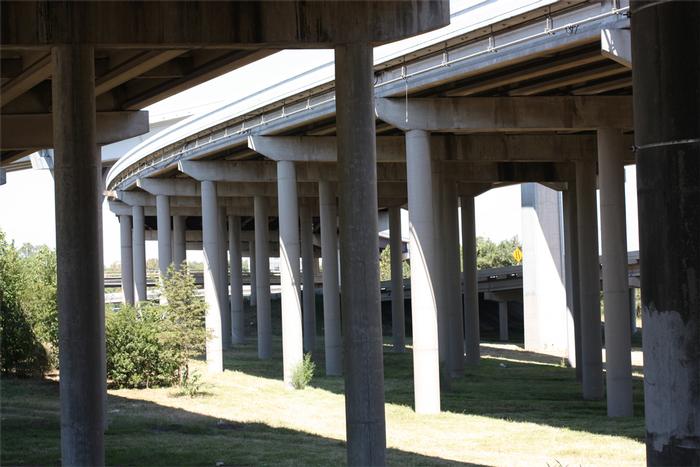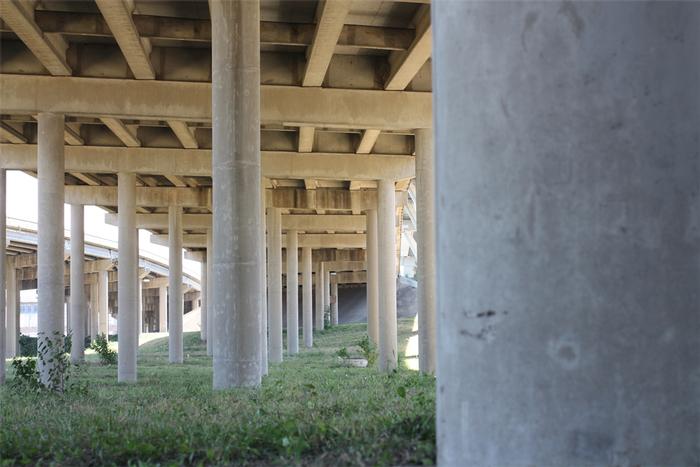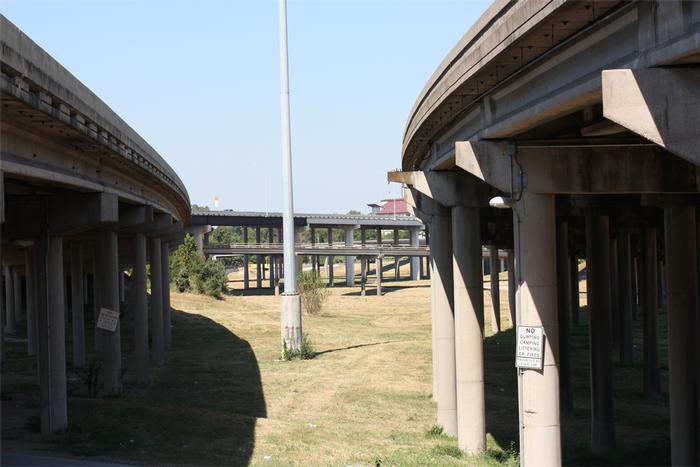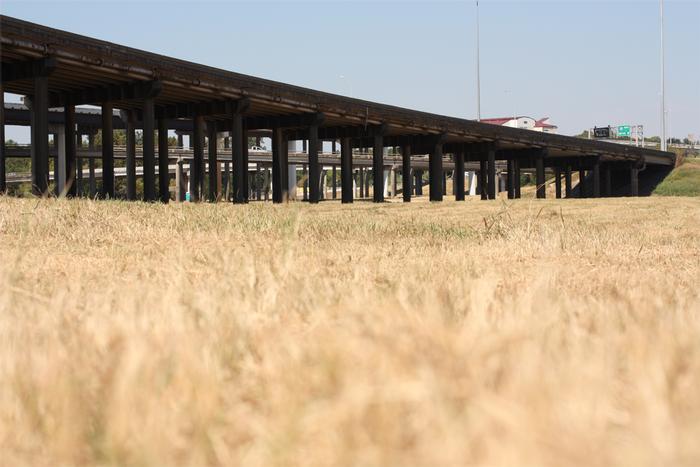[ID:98] Temple in TransitUnited States The ascension, descension, and re-ascension of the highway cuts an undulating landscape across Houston's pervasive flatness. In a city without zoning, these familiar ribbons of concrete impose unofficial boundaries between sprawling communities. As these infrastructural barriers grow in width, so do the winding suburban streets, making it difficult for residents outside the 610 Loop—Houston’s first of three ring roads—to complete everyday tasks without a hefty commute. The vast network of highways dictates its users’ daily schedules, requiring cars to serve as both vehicles and mobile homes away from home. The homogeneous stew of asphalt overrides any sense of place, as each thoroughfare appears virtually indistinguishable from the last. Meanwhile, the residual spaces between highways and island neighborhoods are cluttered with strip malls and billboards, anything to grab the drivers’ attention as they speed from point A to point B. While its most culturally significant buildings repeatedly face the wrecking ball, Houston’s highways only gain in size, authority, and strength. They are Houston’s primary cityscape.
In his speculative project entitled The Broadacre City, American architect Frank Lloyd Wright envisioned an agrarian landscape speckled with towers and neighborhoods connected by highways and flying cars. In his science fiction-like sketches, the metropolis is entirely dispersed, flung to the far corners of the globe by the centrifugal force of mechanized speed. Residents travel via automobile and the pedestrian exists only within the confines of her community’s allotted acre. Although individual air transit is not nearly as common as Wright imagined, other qualities of his Disappearing City have been realized in the sprawl of modern Houston. Known as “Space City” for its distinction as the headquarters of the National Aeronautics and Space Administration, Houston’s highways must have seemed fitting developments in this futuristic place. Now they are mundane and unremarkable, their progressive allure having long since faded. The intersection of Interstate 10, Interstate 45, Buffalo Bayou, and White Oak Bayou is one of the busiest in the city, as it simultaneously directs traffic west to San Antonio and north to Dallas. Residents traveling in and out of downtown spend a significant number of hours each week on these elevated roads. They urgently weave their cars around others, ignoring all existence off their driven path. They speed past one exit sign after another, each string of text becoming blurrier than the last.
Beneath this intersection lies a peninsular neighborhood stranded in Houston’s flood plain. From among the small, visibly aged houses, one can see the svelte curves of the infrastructure seamlessly sweeping cars into the air before gliding them down to their new paths. Silhouetted against the sky, its taut sinews are perched upon stilts which seem to tether them to the ground. Enormous and well financed, the highway willfully passes over and further isolates the dwellers below. In this cast-off place are the foundations of the Broadacre fantasy as it has been realized, left behind by a society focused ever ahead.
As a pedestrian draws nearer to the highway, she passes one final street of houses before emerging into a forlorn field. Approaching the pillars which populate the space, she feels as if she has encountered a ruined temple long since faded from memory. Overhead, the girders no longer defy their weight, bearing down as massive lintels. As she crosses beneath the first ribbon of roads, she walks into an enormous open courtyard. Rhythmic lines of columns serve as the arcade which bounds this cloister. They channel the wanderer’s vision in gently sweeping paths and create subtle thresholds as she moves through the layers of space. The pillars feel cool and grainy to the touch. The brush of a finger releases a tiny shower of sand. The dry, earthy odor of straw wafts through the slow air like smoke from a censer.
The silence is broken by the rhythm of cars racing overhead... ku-coonk ku-coonk... ka-coonk ka-coonk... ka-coonk ka-coonk... Here, at the convergence of two of the city’s great arteries, one can listen to its pulse. It is a privileged encounter, a furtive intrusion into the space of an oblivious host. The concrete machine systematically routes traffic through its center and regulates the space around it. Its assembly of columns marches from downtown Houston, past an abandoned stretch of land, and toward a new horizon. In the heat of summer, they cast crisp, high contrast shadows over the cowering field, insistent reminders of its subordinate order. The precisely cast piles, once white and smooth, begin to show their age as engine oil seeps down their length. Where they authoritatively penetrate the field, weeds sprout around them. The grass remains low and quiet, soft and green. Its appearance is carefully manicured and maintained as if it were the host’s private suburban lawn. Where the grass emerges from the shade of the highway to meet the sun, it reverts to its natural self, a rough, bleached straw. The juxtaposition of the concrete and the pasture highlights the disparity between Houston’s two identities. It creates a rare sense of place in the rural city.
The arching curve of the highway separates a world clouded with strife and noise from another clarified by serenity and distance. The two worlds exist in parallel, allowing the wanderer below to sense but never interact with the drivers above. The constant hum of motor vehicles overhead only suggests movement; their masses and shadows remain entirely hidden above the dividing infrastructure. In turn, the sensed transit implies the fluctuating presence of a population repeating its daily grind. The pedestrian is spatially and visually isolated from Houston’s life force; she occupies a rare space inaccessible to the automobile. Unlike the choked underpasses familiar to today’s city dwellers, the residue left by this particular intersection of highways is eerily static, save for the ever so slight swaying of the straw and the subtle changes in the seasons. By virtue of its forgottenness, it is a sacred refuge from the surrounding buzz, hidden in plain sight.
A field beneath the highway may seem like a strange place to find a sacred space. People go through great effort to define spaces as sacred, toiling for centuries to build grand pyramids, temples, cathedrals, and mosques. Sometimes, however, the sacred spaces that we strive to create have been already made, either unwittingly by us or through the forces of nature. These spaces are no less potent in their ability to inspire. They must be found, either stumbled upon or sought. It is the very act of finding that gives these sacred spaces much of their meaning. The discovery is a revelation that creates a new sacredness. A hiker in the woods may find a secluded meadow to be a spiritually powerful place; similarly, a nomad in the desert may discover an oasis. Within the city there also exist these kinds of spaces. In a field underneath a highway, we discovered a sanctum for the wanderers of Houston.
A sojourn through Houston can be a lonely experience. Fellow pedestrians pass in intervals of many minutes if not hours. Walking alongside gleaming cars which rush by narrow or non-existent sidewalks, one can feel the stares of their drivers safely encased behind steel and glass. The pedestrian is distinctly an outsider, even a nuisance. In this space beneath the intersection, however, the wanderer is directly adjacent to, yet remote from, the traffic. She can safely take in the sounds of the zooming cars without being threatened by them. The field is a sanctuary both from and of the car.
A sacred space is a product of the people who hold it sacred; it exists for them and through them. To the eye of an outsider, it may seem insignificant. The sacred is a conversation between the inhabitant and the space, and the meaning of that relationship is determined by both contributors. A sanctum connects the inhabitant to other entities, mortal or divine: for example, to other members of a congregation; to those who have passed there before; to those who reside there in spirit; or even to the inner self. The connection between the wanderer below the highway and the hidden but palpable throngs of humanity above exemplifies such a relationship. The common thread between sacred spaces is this type of connection across time, space, or dimensional reality. In a house of worship, one is connected to God or gods; on a hallowed battlefield, one feels communion with the fallen. Beneath the highway, the wanderer is simultaneously removed from and connected to citizens performing their daily struggle. Their collective energies imbue the space with a powerful aura. As with all sacred spaces, the connection is faint and fragile. A tranquil atmosphere is needed to experience it, to feel its tremors and to understand its subtle language. This shaded sanctuary beneath the highway acts as a medium between the wanderer below and the suburbanites above. Immersed in its muted echoes, she can begin to contemplate the lives of others. The average underpass, with its congested traffic, blaring horns, changing lights, and scattered detritus, cannot nurture this meditation. This space filters and disarms the torrents of activity above. Its streaking overpasses and muffled staccato thumps convey a feeling of frenzy, yet all is still.
The sacred need not imply permanence. There are many examples of sacred spaces and artworks celebrated for their transitory nature. For Tibetan monks, the destruction of their intricate and colorful sand paintings is as integral to the ritual as their creation. Japanese architect Shigeru Ban’s Paper Dome church in Takatori was a temporary place of worship, yet it provided hope and comfort in a time of crisis. Its disassembly signaled the end of reconstruction and a new beginning. The sacred can be fleeting; sometimes it is meant to be.
Sacred spaces are products of ideologies—here, of mutual isolation, compulsive speed, passing over, and leaving behind. While the residue of the Houston highway system is at times strangely beautiful, its merits do not justify the sprawl, social segregation, and pollution associated with it. Because this site could never serve as a traditional vehicular underpass, it provides a unique opportunity to begin anew by purposefully nullifying the field’s sacred qualities. This process would begin with small gestures. At first, the construction of a sidewalk or trail may infringe upon the highway’s monopoly of the site. The residual space would evolve from an un-occupiable space to a traversable space. The coming and going of pedestrians and bikers would slowly deteriorate the tranquility and seclusion vital to its sacredness. Although the gradual introduction of traffic would sacrifice the integrity of the site as a refuge, it would do a greater service to the city by stitching one peninsular neighborhood to another.
As the path becomes an increasingly common avenue of transit, its users may adapt the adjacent field to serve as a recreational space. The site would become a park, a destination of its own merit. The now occupiable space would establish a center of community between the two neighborhoods. While its co-option would willfully change the site beyond recognition, the conscious rejection of the highway would facilitate interaction and unity.
Once these communities densify, their residents’ dependence on the automobile may diminish. Without the car, the highway would cease to function. The former icon of progress would eventually become a relic of an antiquated mode of transit. Pedestrians and bikers may one day visit this monument to learn about an historic, isolated Houston.
As it exists today, the site is a product of unconscious abandonment. Its form is nothing more than a neglected, residual space beneath the highway. An anomaly in Houston, it derives its sacred character through its capacity to connect the inhabitant with her fellow citizens and to elicit contemplation about their separate lives. Its inherent qualities created a ready-made sacred space that was waiting to be discovered. Unlike buildings intentionally designed for meditation, the found sanctum is a serendipitous entity whose stability is uncertain. If it were to change even slightly, its balance would be lost. The site is significant precisely because it remains undisturbed and because that purity is valued by the person who finds it. For this reason, it cannot be enhanced or saved. This kind of sacred space exists only within a particular time and place. The field below the highway will likely remain intact for some time to come, but its effects are ultimately transitory. Rather than mourn the loss or attempt to avert the inevitable, we should cherish the space while it lasts, like a flower which will soon wither. Its demise may signal the creation of a better future, one not so dominated by isolation and distance.
If you would like to contact this author, please send a request to info@berkeleyprize.org. |




